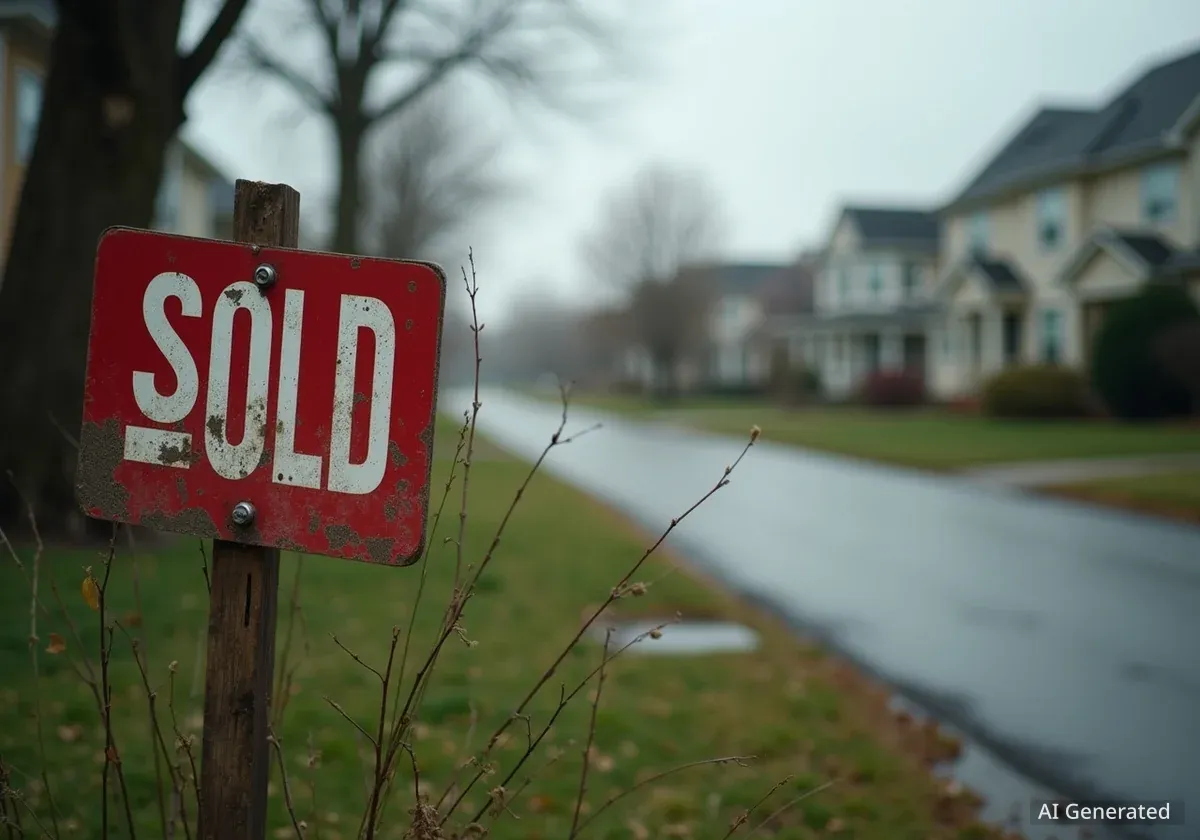The U.S. real estate franchise sector experienced near-zero growth last year, with total sales inching up by a mere 0.1 percent to $26.13 billion. This stagnation reflects a market grappling with persistent high interest rates, rising construction costs, and waning consumer confidence, leading to the lowest number of home sales since 1995.
While some major brands like Keller Williams Realty and United Real Estate posted modest gains, others, including Re/Max and HomeVestors, saw sales decline. The challenging economic environment has forced companies to adapt, with many focusing on agent training and seeking opportunities in a consolidating market.
Key Takeaways
- Real estate franchise sales grew by only 0.1% in 2024, totaling $26.13 billion.
- National home sales dropped to 4.06 million, the lowest level recorded in nearly three decades.
- High mortgage rates, which peaked at 7.22% during the year, significantly impacted buyer affordability.
- New home construction projects decreased by 3.9%, further tightening supply.
- Companies are responding by intensifying agent training and exploring merger and acquisition opportunities.
A Market Under Pressure
The real estate industry faced significant headwinds throughout last year, creating a difficult landscape for both buyers and sellers. A combination of economic factors contributed to a slowdown that was felt across the country, impacting major franchise brands and independent agents alike.
According to data from Freddie Mac, the 30-year fixed-rate mortgage began 2024 at 6.62 percent and climbed as high as 7.22 percent before settling at 6.85 percent by year's end. This sustained period of high borrowing costs directly reduced affordability for prospective homebuyers, causing many to delay their purchasing decisions.
By the Numbers
The National Association of Realtors reported that home sales in the U.S. fell to 4.06 million in 2024, a decline from 4.09 million in 2023 and the lowest figure recorded since 1995.
Larry Goodman, CEO of HomeVestors, explained the direct impact of these economic conditions. “Obviously interest rates rising reduces affordability for buyers, slows home sales and extends holding periods,” he said. Goodman also noted that persistent inflation has driven up the costs of construction and renovation, squeezing profit margins for investors and developers.
Diverging Fortunes Among Major Brands
While the overall market remained flat, performance varied significantly among the top real estate franchises. Some managed to navigate the challenging environment and achieve growth, while others experienced sales declines.
Two brands that bucked the trend were Keller Williams Realty and United Real Estate. Keller Williams saw its sales increase by 1.4 percent, rising from $9.9 billion to $10.03 billion. United Real Estate posted an even stronger performance with a 4.8 percent sales boost, growing from $627 million to $657 million.
Conversely, other industry giants felt the strain. Re/Max, the highest-ranking real estate brand on the Franchise Times Top 400, reported a 0.7 percent drop in sales to $10.34 billion. Other notable declines included Berkshire Hathaway HomeServices, which fell 0.4 percent, and HomeVestors, which saw a 4 percent slide to $1.59 billion.
Median Home Prices Fluctuate
Median home sales prices showed volatility throughout the year. The first quarter of 2024 started with a median price of $426,800, which slightly decreased to $419,300 by the end of the year. The downward trend has continued into 2025, with the median price falling to $410,800 in the second quarter.
Strategies for a Challenging Market
In response to the market slowdown, real estate companies are deploying new strategies to maintain momentum and support their agents. A common theme is a renewed focus on education and operational efficiency.
Rick Haase, President of United Real Estate, attributed his company's success to a proactive approach. “We doubled down and tripled down on our agent training, education and development,” Haase stated. He explained that this included re-skilling agents on financial tools like adjustable-rate mortgages and interest rate buydowns to help clients navigate affordability challenges.
“When the market strikes down, you better be doing some really good things with your company to outperform that. Fortunately, we’re doing the right things.”
Haase noted that his company outperformed the general market in 55 of the 58 markets it tracks. He also sees the current climate as an opportunity for strategic growth.
“In a protracted market, there may be smaller companies that don’t have a critical mass of revenue or agents to drive sales, so they’re saying, ‘maybe I’ll be stronger with United Real Estate,’” Haase said, highlighting the potential for mergers and acquisitions.
Finding Opportunities Amid Uncertainty
Despite the difficult conditions, some leaders see pockets of opportunity. For HomeVestors, which specializes in purchasing homes for cash, the focus has shifted toward affordability.
“Our average sales price overall is in the $260,000 range,” Goodman said. This is significantly lower than the national median list price of $440,000 recorded in July, positioning the company to serve a segment of the market that is particularly sensitive to price.
Goodman emphasized the company's reliance on its established business model, which has facilitated the purchase of over 150,000 homes. He also pointed to the brand's 95 percent consumer satisfaction rating and an extensive vendor network that saves franchisees more than $10 million annually as key strengths.
As the market continues to adjust to economic realities, the ability of real estate brands to adapt through training, technology, and strategic acquisitions will likely determine their success in the coming year.





